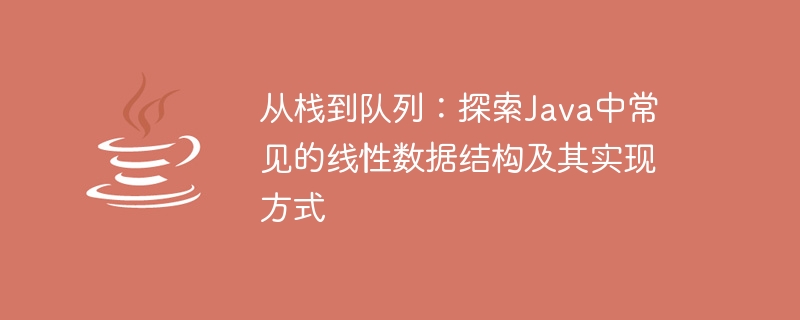Java의 일반적인 선형 데이터 구조 및 구현: 스택에서 큐까지 탐색
- WBOYWBOYWBOYWBOYWBOYWBOYWBOYWBOYWBOYWBOYWBOYWBOYWB원래의
- 2023-12-26 16:55:121202검색

스택에서 큐까지: Java의 일반적인 선형 데이터 구조와 구현 방법을 살펴보세요.
소개:
컴퓨터 과학에서 데이터 구조는 데이터를 구성하고 저장하는 방법입니다. 선형 데이터 구조는 그 중 하나이며 데이터 요소 간의 명확한 문맥 관계가 특징입니다. Java 개발에서 일반적인 선형 데이터 구조에는 매우 자주 사용되는 스택과 큐가 포함됩니다. 이 기사에서는 스택과 큐가 Java에서 구현되는 방법을 심층적으로 살펴보고 특정 코드 예제를 제공합니다.
1. 스택의 개념 및 구현:
스택은 LIFO(후입선출) 데이터 구조입니다. 그 특징은 삽입과 삭제 작업이 스택 상단에서만 수행될 수 있다는 것입니다. Java에는 배열 기반 구현과 연결 목록 기반 구현이라는 두 가지 일반적인 스택 구현이 있습니다.
- Array 기반 스택 구현:
Array는 지속적으로 저장되는 데이터 구조이므로 스택 구현에 매우 적합합니다. 다음은 배열 기반 스택 클래스의 샘플 코드입니다.
public class ArrayStack {
private int[] stack;
private int top; // 栈顶指针
public ArrayStack(int capacity) {
stack = new int[capacity];
top = -1;
}
public boolean isEmpty() {
return top == -1;
}
public boolean isFull() {
return top == stack.length - 1;
}
public void push(int item) {
if (isFull()) {
throw new RuntimeException("Stack is full");
}
stack[++top] = item;
}
public int pop() {
if (isEmpty()) {
throw new RuntimeException("Stack is empty");
}
return stack[top--];
}
public int peek() {
if (isEmpty()) {
throw new RuntimeException("Stack is empty");
}
return stack[top];
}
}- 연결된 목록 기반 스택 구현:
연결된 목록은 비연속 저장소 데이터 구조이며 스택 구현에도 적합합니다. 다음은 연결리스트 기반 스택 클래스의 샘플 코드입니다.
public class LinkedStack {
private Node top;
public LinkedStack() {
top = null;
}
public boolean isEmpty() {
return top == null;
}
public void push(int item) {
Node newNode = new Node(item);
newNode.next = top;
top = newNode;
}
public int pop() {
if (isEmpty()) {
throw new RuntimeException("Stack is empty");
}
int item = top.data;
top = top.next;
return item;
}
public int peek() {
if (isEmpty()) {
throw new RuntimeException("Stack is empty");
}
return top.data;
}
private class Node {
private int data;
private Node next;
public Node(int data) {
this.data = data;
this.next = null;
}
}
} 2. 큐의 개념 및 구현:
큐는 FIFO(선입선출) 데이터 구조입니다. 그 특징은 큐의 끝에만 요소를 삽입하고 큐의 선두에 있는 요소를 삭제할 수 있다는 것입니다. Java에는 배열 기반 구현과 연결 목록 기반 구현이라는 두 가지 일반적인 대기열 구현이 있습니다.
- 배열 기반 대기열 구현:
배열 기반 스택 구현과 유사하게 다음은 배열 기반 대기열 클래스의 샘플 코드입니다.
public class ArrayQueue {
private int[] queue;
private int front; // 队头指针
private int rear; // 队尾指针
public ArrayQueue(int capacity) {
queue = new int[capacity + 1]; // 额外预留一个空位
front = rear = 0;
}
public boolean isEmpty() {
return front == rear;
}
public boolean isFull() {
return (rear + 1) % queue.length == front;
}
public void enqueue(int item) {
if (isFull()) {
throw new RuntimeException("Queue is full");
}
queue[rear] = item;
rear = (rear + 1) % queue.length;
}
public int dequeue() {
if (isEmpty()) {
throw new RuntimeException("Queue is empty");
}
int item = queue[front];
front = (front + 1) % queue.length;
return item;
}
public int peek() {
if (isEmpty()) {
throw new RuntimeException("Queue is empty");
}
return queue[front];
}
}- 연결 목록 기반 대기열 구현:
연결 목록과 유사 기반 스택 구현, 다음은 연결 목록 기반 큐 클래스의 샘플 코드입니다.
public class LinkedQueue {
private Node front; // 队头指针
private Node rear; // 队尾指针
public LinkedQueue() {
front = null;
rear = null;
}
public boolean isEmpty() {
return front == null;
}
public void enqueue(int item) {
Node newNode = new Node(item);
if (isEmpty()) {
front = newNode;
rear = newNode;
} else {
rear.next = newNode;
rear = newNode;
}
}
public int dequeue() {
if (isEmpty()) {
throw new RuntimeException("Queue is empty");
}
int item = front.data;
front = front.next;
if (front == null) {
rear = null;
}
return item;
}
public int peek() {
if (isEmpty()) {
throw new RuntimeException("Queue is empty");
}
return front.data;
}
private class Node {
private int data;
private Node next;
public Node(int data) {
this.data = data;
this.next = null;
}
}
}결론:
스택과 큐는 Java에서 일반적으로 사용되는 선형 데이터 구조이며 이를 구현하는 방법에는 여러 가지가 있습니다. 이 문서에서는 배열 기반 및 연결 목록 기반 스택 및 큐 구현을 소개하고 특정 코드 예제를 제공합니다. 개발자는 프로그램의 효율성과 유지 관리성을 향상시키기 위해 실제 요구 사항에 따라 적절한 구현 방법을 선택할 수 있습니다.
위 내용은 Java의 일반적인 선형 데이터 구조 및 구현: 스택에서 큐까지 탐색의 상세 내용입니다. 자세한 내용은 PHP 중국어 웹사이트의 기타 관련 기사를 참조하세요!

